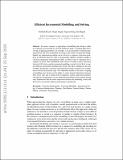Files in this item
Efficient incremental modelling and solving
Item metadata
| dc.contributor.author | Koçak, Gökberk | |
| dc.contributor.author | Akgün, Özgür | |
| dc.contributor.author | Dang, Nguyen | |
| dc.contributor.author | Miguel, Ian | |
| dc.date.accessioned | 2021-07-16T10:30:11Z | |
| dc.date.available | 2021-07-16T10:30:11Z | |
| dc.date.issued | 2020-09-07 | |
| dc.identifier | 274776428 | |
| dc.identifier | ae7faa00-6d3d-4ecb-b19a-14df924e2088 | |
| dc.identifier.citation | Koçak , G , Akgün , Ö , Dang , N & Miguel , I 2020 , Efficient incremental modelling and solving . in ModRef 2020 - The 19th workshop on Constraint Modelling and Reformulation . The 19th workshop on Constraint Modelling and Reformulation (ModRef) , Louvain-la-Neuve , Belgium , 7/09/20 . < https://arxiv.org/abs/2009.11111 > | en |
| dc.identifier.citation | workshop | en |
| dc.identifier.other | ArXiv: http://arxiv.org/abs/2009.11111v1 | |
| dc.identifier.other | ORCID: /0000-0002-6930-2686/work/96141181 | |
| dc.identifier.other | ORCID: /0000-0001-9519-938X/work/96141245 | |
| dc.identifier.other | ORCID: /0000-0002-2693-6953/work/96141538 | |
| dc.identifier.uri | https://hdl.handle.net/10023/23589 | |
| dc.description | Funding: This work is supported by EPSRC grant EP/P015638/1. Nguyen Dang is a Leverhulme Trust Early Career Fellow (ECF-2020-168). | en |
| dc.description.abstract | In various scenarios, a single phase of modelling and solving is either not sufficient or not feasible to solve the problem at hand. A standard approach to solving AI planning problems, for example, is to incrementally extend the planning horizon and solve the problem of trying to find a plan of a particular length. Indeed, any optimization problem can be solved as a sequence of decision problems in which the objective value is incrementally updated. Another example is constraint dominance programming (CDP), in which search is organized into a sequence of levels. The contribution of this work is to enable a native interaction between SAT solvers and the automated modelling system Savile Row to support efficient incremental modelling and solving. This allows adding new decision variables, posting new constraints and removing existing constraints (via assumptions) between incremental steps. Two additional benefits of the native coupling of modelling and solving are the ability to retain learned information between SAT solver calls and to enable SAT assumptions, further improving flexibility and efficiency. Experiments on one optimisation problem and five pattern mining tasks demonstrate that the native interaction between the modelling system and SAT solver consistently improves performance significantly. | |
| dc.format.extent | 15 | |
| dc.format.extent | 574628 | |
| dc.language.iso | eng | |
| dc.relation.ispartof | ModRef 2020 - The 19th workshop on Constraint Modelling and Reformulation | en |
| dc.subject | Constraint programming | en |
| dc.subject | Constraint modelling | en |
| dc.subject | Incremental solving | en |
| dc.subject | Constraint optimization | en |
| dc.subject | Planning | en |
| dc.subject | Data mining | en |
| dc.subject | Itemset mining | en |
| dc.subject | Pattern mining | en |
| dc.subject | Dominance programming | en |
| dc.subject | QA75 Electronic computers. Computer science | en |
| dc.subject | NDAS | en |
| dc.subject.lcc | QA75 | en |
| dc.title | Efficient incremental modelling and solving | en |
| dc.type | Conference item | en |
| dc.contributor.sponsor | The Leverhulme Trust | en |
| dc.contributor.institution | University of St Andrews. School of Computer Science | en |
| dc.contributor.institution | University of St Andrews. Centre for Interdisciplinary Research in Computational Algebra | en |
| dc.identifier.url | https://www-users.cs.york.ac.uk/~frisch/ModRef/ | en |
| dc.identifier.url | https://arxiv.org/abs/2009.11111 | en |
| dc.identifier.grantnumber | ECF-2020-168 | en |
This item appears in the following Collection(s)
Items in the St Andrews Research Repository are protected by copyright, with all rights reserved, unless otherwise indicated.

